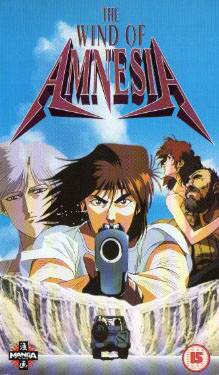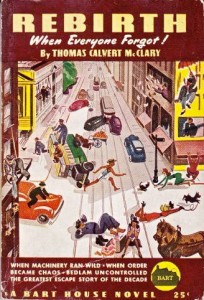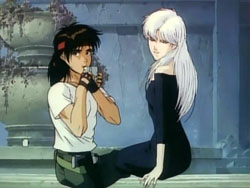 Kaze no Na wa Amnesia (A Wind Named Amnesia), directed by Kazuo Yamazaki. 80 minutes. December 22, 1990.
Kaze no Na wa Amnesia (A Wind Named Amnesia), directed by Kazuo Yamazaki. 80 minutes. December 22, 1990.
This was one of the most popular OAVs of the 1990s and early 2000s. It was based on an October 1983 s-f novel by Hideuchi Kikuchi, the author of the novels on which Vampire Hunter D and Wicked City were made. It was produced by Studio Madhouse, a leading anime studio and directed by Kazuo Yamazaki (Urusei Yatsura). The Japanese VHS release by Japan Home Video was in 1990 but the American DVD release wasn’t until January 19, 1999 (from Central Park Media). I assumed at the time that JHV had wanted too much money for the American license, or that a bidding war had taken place through most of the 1990s for it. DVD technology had become available in 1995, but by 1999 the VHS video tapes were still widespread, so the American release on DVD was also a mark of prestige.
A Wind Named Amnesia was greeted as a highly imaginative and original s-f plot by Kikuchi. I considered it highly derivative of a forgotten American s-f novel, Rebirth by Thomas Calvert McClary, serialized in Astounding Stories in February and March 1934 and reprinted as one of the first paperback novels in 1944. I thought that McClary’s version was much more realistic, although I understood why the video version was so visually bowdlerized. The video synopsis was:
“It happened quite suddenly, with no warning – all the memories of all the people on Earth, swept away as if by a sudden wind. In a post-catastrophic Earth populated mostly by savages without memories of their past civilisation, one man travels on a journey of enlightenment and hope, across a devastated America.”
 McClary’s novel was a panorama across America with no central characters. It ahowed the result of total amnesia: no memories, no knowledge of speech, clothes, or modesty. The video had to impose a plot on this concept, and to be discreet. In McClary’s novel, people relieved themselves automatically in their clothes for the first couple of days until they discovered the comfort of tearing off their pants and going nude below the waist to relieve themselves openly. That could be described in a text novel, but it couldn’t be shown in a video. The novel described all the men as completely naked and with long hair and beards after four or five months. In the video they are still fully dressed and with short hair and only a light stubble after two years. Most anime fans did not seem to consider this unrealistic.
McClary’s novel was a panorama across America with no central characters. It ahowed the result of total amnesia: no memories, no knowledge of speech, clothes, or modesty. The video had to impose a plot on this concept, and to be discreet. In McClary’s novel, people relieved themselves automatically in their clothes for the first couple of days until they discovered the comfort of tearing off their pants and going nude below the waist to relieve themselves openly. That could be described in a text novel, but it couldn’t be shown in a video. The novel described all the men as completely naked and with long hair and beards after four or five months. In the video they are still fully dressed and with short hair and only a light stubble after two years. Most anime fans did not seem to consider this unrealistic.
San Francisco, 1999, two years after the Wind. Feral men around a fire in the ruins of the city are caught by a computerized Guardian robot, which kills them for breaking the law. A young man in a jeep drives into the scene, and hurriedly flees. Sophia, a mysterious white-haired woman, tells him telepathically how to destroy the robot.
A flashback shows who they are. It begins in a small town in Montana as the Wind destroys all memories. A teenager wanders into the ruins of a nearby secret military research base where experiments were being conducted to protect America. One them had been to mentally connect Johnny, a sickly crippled boy, to a computer. The computer restored Johnny’s memory after everyone else lost theirs. The teenager saves Johnny’s life from another experimental man turned killer.
 In the next few months Johnny uploads all the information he can into the teenager, who he names Wataru, the Japanese word for traveler. Johnny charges Wataru with traveling throughout America, looking for any other refuges of memory; or finding others who will join him and let him teach them. The sickly Johnny finally dies. Just before Wataru sets out, he is joined by the mysterious Sophia.
In the next few months Johnny uploads all the information he can into the teenager, who he names Wataru, the Japanese word for traveler. Johnny charges Wataru with traveling throughout America, looking for any other refuges of memory; or finding others who will join him and let him teach them. The sickly Johnny finally dies. Just before Wataru sets out, he is joined by the mysterious Sophia.
After San Francisco, Wataru and Sophia drive to Los Angeles where they meet Sue and Little John. Sue is being sacrificed to a feral tribe’s god – actually a computerized urban construction robot – despite Little John’s attempts to save her. But Wataru does and he invites them to join him; but …
I don’t want to give away any spoilers, but they don’t. Sophia, who says, “You’ve probably guessed by now that my people are responsible for the Wind,” bets Wataru that nobody will join them on their trip across America; that mankind will not survive. Wataru takes the bet.
 They continue their drive across America, but are attacked again by the Guardian robot from San Francisco. It is self-repairing, and has locked Wataru into its computer memory as a criminal to be killed. They escape it to the Eternal City, built just before the Wind to be a computerized perfect city. They discover that it has only two inhabitants; old Mr. Simpson and teenage Lisa. (Lisa Simpson!?) They have been programmed by the Eternal City to act out as all the City’s inhabitants: the hospital’s head doctor and a call nurse; a restaurant’s waiter and a diner; the mayor and her assistant. Wataru declines Mayor Lisa’s (which he realizes is the Computer’s) offer to stay and become a permanent citizen. Again he tries unsuccessfully to invite Lisa to join them.
They continue their drive across America, but are attacked again by the Guardian robot from San Francisco. It is self-repairing, and has locked Wataru into its computer memory as a criminal to be killed. They escape it to the Eternal City, built just before the Wind to be a computerized perfect city. They discover that it has only two inhabitants; old Mr. Simpson and teenage Lisa. (Lisa Simpson!?) They have been programmed by the Eternal City to act out as all the City’s inhabitants: the hospital’s head doctor and a call nurse; a restaurant’s waiter and a diner; the mayor and her assistant. Wataru declines Mayor Lisa’s (which he realizes is the Computer’s) offer to stay and become a permanent citizen. Again he tries unsuccessfully to invite Lisa to join them.
Wataru and Sophia drive on. They see the ruins of Las Vegas, and continue to the East Coast and Washington, D.C., where the self-repairing Guardian killer robot finds them again. It chases them to New York City. The climax is supposed to be mystical yet uplifting.
A Wind Named Amnesia showed its OAV budgetary limitations in several ways, especially its limited number of background characters. Still, it was a prestige release by Central Park Media under its own “intellectual” label, not its more common U.S. Renditions for anime adventure. It was also uncommon for being released first on DVD, on January 19, 1999, and not on VHS tape (separate dubbed and subtitled releases) until August 6, 2002.
Next week: “Forgotten” OAVs #27.


 Fred Patten (1940-2018) was an internationally respected comics and animation historian. He has written about anime or comic books for publications ranging from Animation Magazine and Alter Ego to Starlog. He was a contributor to The Animated Movie Guide (2005), and is author of Watching Anime, Reading Manga (2004, Stone Bridge Press), a collection of his best essays, and Funny Animals and More (2014, Theme Park Press), based upon his early columns here on Cartoon Research. He passed away on November 12th, 2018.
Fred Patten (1940-2018) was an internationally respected comics and animation historian. He has written about anime or comic books for publications ranging from Animation Magazine and Alter Ego to Starlog. He was a contributor to The Animated Movie Guide (2005), and is author of Watching Anime, Reading Manga (2004, Stone Bridge Press), a collection of his best essays, and Funny Animals and More (2014, Theme Park Press), based upon his early columns here on Cartoon Research. He passed away on November 12th, 2018.





































Finding out this was cribbed from a much earlier book, it’s interesting to notice those differences, though I suppose, even if Rebirth had been adapted into a film of sorts, it probably wouldn’t had flied very well a century back given the issue of relieving oneself in their own clothes (which already is a fetish these days). I could live with the suspended belief A Wind Name Amnesia presents of brain dead sloths who still see a need for keeping something on while also managing to keep themselves well groomed against all obstacles. I suppose I do wonder what the original novel Kikuchi wrote was like.
If there’s one thing about the film I could look back on with some thoughts, it’s how rather crammed it is for an OAV. Reviewer of long-running podcast who did a review of A Wind Named Amnesia a decade ago felt the same way I did in wishing this had been told as a TV series with the adventure through the US padded out each stop they take, one of them thought it reminded him of Galaxy Express 999 through the idea of Wataru and that woman driving cross-country like that.
http://www.awopodcast.com/2006/07/anime-world-order-show-28-fantastic.html
A Wind Named Amnesia showed its OAV budgetary limitations in several ways, especially its limited number of background characters. Still, it was a prestige release by Central Park Media under its own “intellectual” label, not its more common U.S. Renditions for anime adventure.
Actually it was “US. Manga Corps” that CPM used for most of its regular titles. I think another release that was put out under the CPM namesake include Grave of the Fireflies and Night on The Galactic Railroad. U.S. Rendition was an entirely different company that released anime mainly in the early 90’s (some of their titles were picked up by Manga Entertainment).
Its popularity was of course not a novelty for any new teenage anime series fan those days. Kazuo Yamazaki did a great directing job and made it even brighter with the effects than a novel on which it was based.
Jacob Cooper
https://domyhomeworkonline.net
I love this anime. It’s my favorite movie. U.S. Renditions is not a part of Central Park Media. U.S. Renditions was it’s own company. You are confusing it with US Manga Corps I think